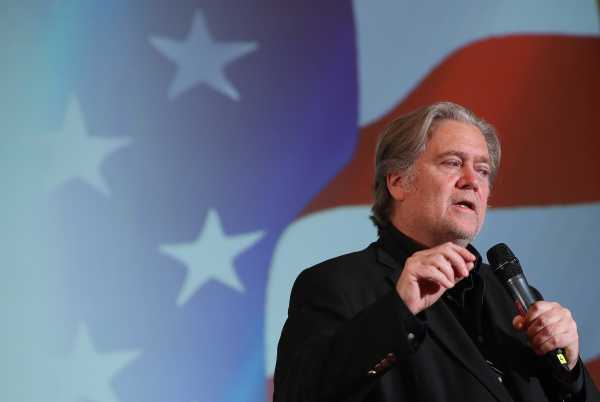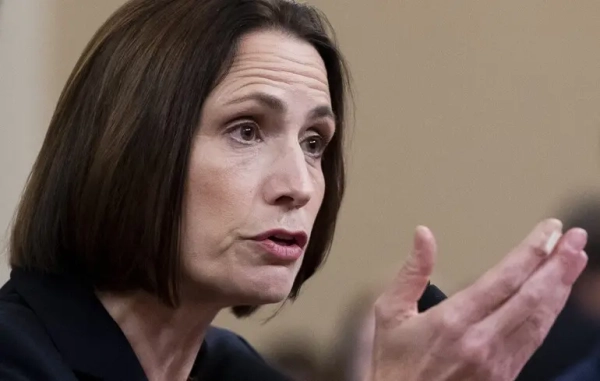
On Sunday, the New Yorker announced that a live interview with Steve Bannon would be a centerpiece of the magazine’s in-person conference, called the New Yorker Festival, in early October. The backlash was fierce and immediate. As the controversy built and marquee speakers began dropping out of the festival, the magazine’s widely respected editor, David Remnick, disinvited Bannon from the event.
“I thought this through and talked to colleagues — and I’ve reconsidered,” Remnick wrote. “Our writers have interviewed Steve Bannon for the New Yorker before, and if the opportunity presents itself I’ll interview him in a more traditionally journalistic setting as we first discussed, and not on stage.”
Bannon wasted little time in firing back. “The reason for my acceptance [of the New Yorker Festival] was simple: I would be facing one of the most fearless journalists of his generation,” he said in a statement. “In what I would call a defining moment, David Remnick showed that he was gutless when confronted by the howling mob.”
This might seem like a story you’ve heard before: A controversial speaking invitation is met with a predictable backlash, leading to a canceled invitation and cries of liberal censorship. But the New Yorker case is particularly interesting. The core questions the incident raises are profound ones: How should journalists think of their jobs in an era when one of America’s governing ideologies is, at root, thinly veiled white nationalism? And how should the media engage with figures who routinely deride them as enemies of the people?
How do you report on Bannon’s America?
The New Yorker Festival is a moneymaking event. The publication brings in famous and/or interesting people, has them sit on panels with New Yorker journalists, and charges readers who are interested in attending. Several other major publications, including the Atlantic and Vox, host similar events.
These kinds of events are, by their very nature, difficult to manage. They need to be attractive to audiences, which means booking interesting and/or controversial speakers. The events need the speakers to show up, which often means paying them, and they might not want to walk into the lion’s den of an adversarial interview in front of a live audience.
At the same time, the interviews themselves can’t betray the core journalistic mission of the publication — they can’t somehow do reporting and brand promotion at the same time. That means the journalists onstage shouldn’t (in theory) just suck up to the speakers and sing their praises — though that’s all too often what happens — but rather should respectfully challenge their ideas and arguments.
This was the spirit in which the Bannon speech was arranged. Initially, the idea was to have Bannon on a podcast, but Remnick realized that a sit-down with Bannon would be an interesting addition to the festival. He openly advertised that he would be challenging the former White House senior strategist on stage.
“I have every intention of asking him difficult questions and engaging in a serious and even combative conversation,” Remnick told the New York Times on Sunday. “The audience itself, by its presence, puts a certain pressure on a conversation that an interview alone doesn’t do.”
Remnick’s comments did little to quell the controversy. Prominent festival panelists, like director Judd Apatow and actor Jim Carrey, threatened to back out if Bannon appeared. New Yorker writer Adam Davidson tweeted on Monday that Remnick had spent “all day today on the phone with writers and staffers telling him he’s wrong.” Kathryn Schulz, a Pulitzer Prize–winning staff writer, publicly called for readers to email Remnick and tell him to disinvite Bannon:
The reasoning behind the backlash was straightforward. Bannon is not just an interesting person in American public life; he is, and long has been, an ideologue who has devoted his life to furthering a particularly noxious strain of right-wing populism.
While editor-in-chief of Breitbart, he claimed that he wanted the site to be “the platform for the alt-right.” He elevated Milo Yiannopoulos, making him a top writer and the editor of Breitbart’s tech section, regularly stoked fears about Muslim and Latino immigration, and published a piece titled “5 Devastating Facts about Black-on-Black Crime.”
In the White House, Bannon was most infamous for writing the initial draft of the travel ban — an extremely sweeping document that threw American airports into chaos and was repeatedly struck down in court as discriminatory. His current project is building an organization in Europe, melodramatically called “the Movement,” designed to bolster Europe’s xenophobic far-right parties in advance of the 2019 European Parliament election.
“Let them call you racists,” Bannon told Europe’s far-right National Front in one speech. “Let them call you xenophobes. Let them call you nativists. Wear it as a badge of honor.”
For these reasons, the dissenting New Yorker staffers argued, Bannon is not someone who deserves a spot on at the New Yorker Festival. Bannon’s worldview won’t be defeated by a tough New Yorker interview, and pretending that he is intellectually deserving of one works to normalize the indefensible.
“I don’t think an advocate for ISIS would have been invited to the Festival. I don’t think a literal Klansman would’ve,” Osita Nwanevu, another New Yorker staff writer, tweeted. “But Bannon was, reflecting an implicit judgement that what Bannon believes lies on the acceptable side of some unspecified but clearly real moral boundary.”
A version of this argument carried the day. In his statement explaining his decision to rescind Bannon’s invite, Remnick said that a live interview at a festival was different than an interview for a print piece in the magazine (which the New Yorker has done before). He stood by the idea of interviewing Bannon, casting it as a valuable exercise for the historical record, but had been persuaded by his own staffers that this was the wrong venue.
Some New Yorker writers publicly disagreed with Remnick’s final decision. Lawrence Wright and Malcolm Gladwell, arguably the publication’s two most famous working writers, sent out dissenting tweets:
Set aside the questionable history in Gladwell’s tweet — it’s not clear that “have you no sense of decency?” actually took down Sen. McCarthy — and you get to the crux of the issue. The question isn’t whether Bannon is odious, but rather how journalists ought to interact with an odious person who has, in fact, played a major role in significant political events.
The Gladwell/Wright view is that Bannon needs to be heard and challenged in order for people to be able to understand the world around them. Ignoring him is tantamount to sticking one’s head in the sand; journalists need to expose all important views, even repugnant ones, and hope that sunlight is the best disinfectant.
It’s a legitimate way of approaching this particular moment in political time. You can’t ignore that the president of the United States is a practitioner of Bannon-style populism, or that it’s widely popular around the European continent. You need to engage where these people are coming from in order to grasp the direction of American and European politics, something I’ve tried to do extensively in my own work. Journalism requires interviewing people to understand their views, even if you think those views are wrong or even offensive.
However, that is not an argument for including Bannon at this particular event, which exists in a strange space between traditional journalism and public relations. Just because it’s good to understand right-wing populism generically does not mean that you should feature one of its proponents in a place of honor at a conference.
On this point, I believe that the critics of the Bannon invite have the upper hand — for reasons that I think the New Yorker’s Jelani Cobb put best.
“I’ve been very critical of ‘normalizing’ the obscene. I’ve also argued that it is sometimes necessary to engage odious, even dangerous figures as a means of exposing them,” Cobb writes. “Interviewing Bannon would’ve been the former but on principle [Remnick] sought to do the latter.”
Why this is about more than just one conference
There are lots of conferences every year, and all of them are faced with difficult decisions about whom to invite and not to invite. Understanding why this one generated so much outrage and conversation — it was all journalism and politics Twitter could talk about on Monday night — requires understanding some broader issues about journalism in the Trump era.
Part of the reason this generated so much interest is the New Yorker’s audience, which represents a very particular kind of liberalism: educated, upper-class, and proud of its intellectual sophistication. A recent Pew Research Center survey of 32 large news sources and programs found that the New Yorker had the most left-leaning audience of them all. To subscribe to the New Yorker, or to read it on public transit, is to make a statement about who you are and what you believe. For someone like Bannon to be included in that space respectfully could seem, to that audience, like a kind of violation.
But more broadly, journalists have been forced into a lose-lose position by an administration and a political movement that have cast them as the enemy.
Around the time of Trump’s inauguration, Bannon gave a revealing interview to the New York Times — in which he told the media establishment to “keep its mouth shut and just listen for a while.”
“The media here is the opposition party,” Bannon said. “They don’t understand this country. They still do not understand why Donald Trump is the president of the United States.”
This notion has reflected the way that the White House and the broader Republican establishment have treated the “fake news” media during the Trump administration. Bannon, per his statement, went into this event seeing it as a kind of joust; Remnick went in seeing it as an opportunity to hold a powerful proponent of a bigoted ideology accountable.
Whatever happened on that festival stage likely would have been a clash that would help Bannon and Trump paint the media as intrinsically hostile to their cause. Engaging with Trumpism, even in good faith, can further their anti-media narrative. So does disinviting Bannon from the festival.
And yet when the country is being run by reprehensible people, the answer for journalists can’t be to simply ignore them or refuse to interview them. As a result, even the most establishmentarian reporters are being forced to become more oppositional in this era. Around the time that the news of Bannon’s disinvitation broke on Monday evening, NBC’s Chuck Todd published a piece in the Atlantic arguing that journalists need to “fight back” against the attacks coming from the White House and Fox News anchors.
The piece is remarkable not because of the sentiments, which are commonly heard among liberal and left journalists, but because of the source. Chuck Todd is a straitlaced political reporter, the host of NBC’s venerable Sunday interview show Meet the Press. He is as establishment as they come, a frequent target of ire from liberals on social media. And here he is saying that reporters need to take a more confrontational attitude toward conservatives — particularly when thinking about who deserves a platform.
“I’m not advocating for a more activist press in the political sense, but for a more aggressive one,” Todd writes. “That means having a lower tolerance for talking points, and a greater willingness to speak plain truths. It means not allowing ourselves to be spun, and not giving guests or sources a platform to spin our readers and viewers, even if that angers them. Access isn’t journalism’s holy grail — facts are.”
This is the double bind journalists find themselves in. If you report on Trump, Bannon, and their fellow travelers the same way you’d cover any previous administration, you risk normalizing the white identity politics and disdain for democratic norms at the heart of the Trumpist project. But if you treat them differently, more worthy of scorn or heightened scrutiny, you come to embody the adversarial role the president has slotted you into.
Sourse: vox.com






